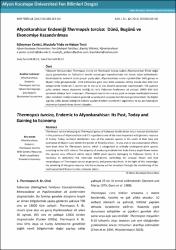Afyonkarahisar endemiği thermopsis turcica: dünü, bugünü ve ekonomiye kazandırılması
Abstract
Fabaceae familyasından Thermopsis cinsine ait Thermopsis turcica sadece Afyonkarahisar İli’nde doğal yayılış göstermekte ve Türkiye’nin önemli yabani gen kaynaklarından biri olarak kabul edilmektedir. Günümüzde bu endemik türün parçalı yayılış alanı, Afyonkarahisar sınırları içindeki Eber Gölü güneyi ve Akşehir Gölü güneybatısıdır. IUCN kriterlerine göre nesli kritik seviyede tehlike altında olan bitki türü kategorisinde listelenen T. turcica için in situ ve ex situ koruma çalışmaları yapılmaktadır. Tek çiçekten çoklu serbest meyve oluşturma özelliği, bu türü Fabaceae familyasına ait yaklaşık 18000 bitki türü içerisinde oldukça farklı kılmaktadır. Thermopsis turcica’nın sıra dışı çiçek ve meyve morfolojisini kontrol eden moleküler mekanizmaların genomik ve proteomik seviyede belirlenmesi gerekmektedir. Bu bilgiler ışığında, çoklu karpel özelliğinin kültürü yapılan bitkilere transferinin sağlanması ile bu gen kaynağının ekonomiye kazandırılması önemli olacaktır. Thermopsis turcica belonging to Thermopsis genus of Fabaceae family shows only a natural distribution
in the province of Afyonkarahisar and it’s regarded as one of the most important wild genomic resource
of Turkey. Today, sectional distribution area of this endemic species is the south of Eber Lake and
southwest of Akşehir Lake within the border of Afyonkarahisar. In situ and ex situ conservation efforts
have been done for Thermopsis turcica, which is categorized as critically endangered plant species
according to the IUCN criteria. The property of producing multiple free fruits from a single flower makes
this species very different within about 18000 plant species belonging to Fabaceae family. It is
necessary to determine the molecular mechanisms controlling the unusual flower and fruit
morphologies of Thermopsis turcica at genomics and proteomics levels. In the light of this knowledge,
the providing of this gene resource into the economy will be important through the transferring of the
multi-carpellated feature to the cultivated plants.
Source
Afyon Kocatepe Üniversitesi, Fen Bilimleri DergisiVolume
12Issue
2Collections
- Cilt 12 : Sayı 2 [10]



















